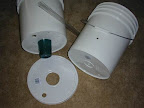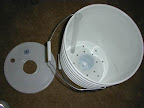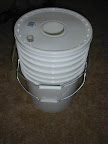While researching a problem I was having with my container gardening project, I ran across something rather interesting– hobbyist hydroponics. While I was aware of the concept of growing plants without soil– a recent visit to Walt Disney World had an exhibit featuring various hydroponic systems on a large scale– I was not aware how many people grow vegetables, herbs, etc, successfully on a small scale.
I found that there are several techniques to grow hydroponically, and that– compared to growing in soil– the results are fantastic. For example, the time from planting tomato seedlings to harvesting vine-ripe mature fruits is significantly shortened– from three months or more down to as little as eight weeks.
I decided to embark upon a new project, and build my own hydroponic system. I settled on a particular design that employed a hybrid concept to supply nutrients to the plants.
It might be best to take a moment and discuss some of the various hydroponic methodologies. The simplest involves just dripping a nutrient solution over the root area of a plant which is physically supported by an inert medium like pea gravel, perlite, or the like. The nutrient is then “discarded”, meaning it is not recirculated over the plant roots again. This isn’t a very efficient or cost-effective method, so it is rarely used.
Another simple technique is to create a bubbler system from plastic bucket-type containers. Stacking a 3.5 gallon bucket in a 5 gallon bucket is a popular design. The smaller bucket’s bottom is perforated and then placed inside the larger The space between the bottoms of the buckets serves as a nutrient reservoir. An aquarium air pump is used to power a tube system that “bubbles up” nutrient solution from the reservoir to the top of the planting media in the top bucket where it trickles down over the roots and, ultimately, drips back into the reservoir through the perforated bottom.
A different approach employs a method know as “ebb and flow”. In this method, plants are placed in an inert medium in small pots which are arranged in a large six-inch deep tray. Using a timer to control a pump in a reservoir below the tray, nutrient solution floods the tray– and the pots– for a specific interval, and then drains back to the reservoir. During this “ebb” time, the plant roots are kept moist by the growing medium, but are also exposed to increased amount of oxygen.
A system similar to ebb and flow, but simpler, is called deep flow. Pots remain submerged in nutrient solution, but the solution is oxygenated and recirculated constantly.
A more sophisticated system, called NFT– Nutrient Film Technique– employs the concepts of both feeding and supplying increased oxygen to the roots, but does them at the same time. Plants are situated in an inert medium in “net pots”, which are plastic pots with many small slots in their sides and bottom. The pots are inserted in the covers of plastic channels, known as gullies, through which a shallow film of nutrient solution flows. The slots in the pots allow roots to grow through the pots down into the nutrient film.
An offshoot of hydroponics is aeropononics. Also a soilless growing method, aeroponics goes one step further to almost eliminate the growing medium itself. In an aeroponic system, plants are suspended with their roots hanging in an opaque chamber. Nutrient is sprayed on the roots or misted in the chamber either constantly or at specific intervals.
My hybrid system employs elements of deep flow, NFT and aeroponics. Rather than have nutrient pumped in at one end of a gully to flow past roots on its way back to the reservoir, it is instead sprayed onto the net pots at each plant site. Additionally, the drain at the reservoir end of the gully is adjustable, allowing the depth of the film flowing down the bottom of the gully to be varied from very thin all the way up to nearly filling the gully. This adjustability allows seedlings placed in the system to start out under the deep flow technique, and, as their roots grow longer, the depth can be lowered allowing more oxygen to the roots in a hybrid aeroponic/NFT system.
This is not an original design. I found a commercially available system that very apparently uses mostly commonly available materials in its construction, so I decided to build one myself. After a few hiccups, I eventually got everything I needed and assembled the system. Some pics here.


